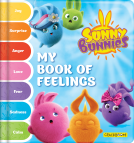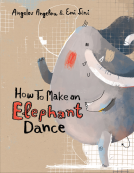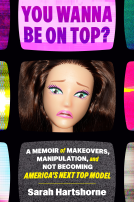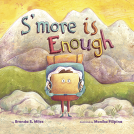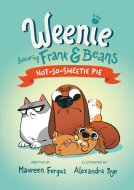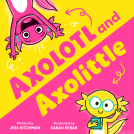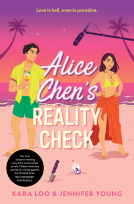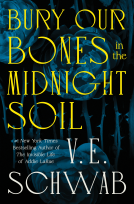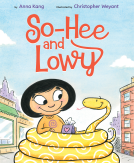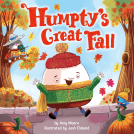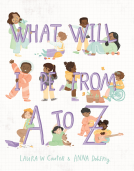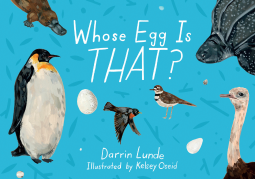
Whose Egg Is That?
by Darrin Lunde
This title was previously available on NetGalley and is now archived.
Send NetGalley books directly to your Kindle or Kindle app
1
To read on a Kindle or Kindle app, please add kindle@netgalley.com as an approved email address to receive files in your Amazon account. Click here for step-by-step instructions.
2
Also find your Kindle email address within your Amazon account, and enter it here.
Pub Date Jan 31 2023 | Archive Date Jan 31 2023
Talking about this book? Use #WhoseEggIsThat #NetGalley. More hashtag tips!
Description
Written by a mammalogist at the Smithsonian, this clever preschool page-turner pairs seven eggs with information about the animals' survival mechanisms, asking kids to guess which animal laid which egg. Whose Egg Is That? reveals the animals--ranging from penguins to platypuses--in their own habitats.
Available Editions
| EDITION | Other Format |
| ISBN | 9781623543297 |
| PRICE | $17.99 (USD) |
| PAGES | 32 |
Featured Reviews
 Educator 818866
Educator 818866
This book was so cute! As a preschool teacher I love when non-fiction books offer fun ways for children to connect with the material. This book offered a fun guessing game which allows children to use context clues to guess which animal the egg belongs to. I can already think of so many ways to extend this book into the class and can’t wait to add it to my classroom library.
Super cute illustrations, great facts. Would have liked it to be 2-3 animals longer, but overall, really enjoyed this book. Will be rereading w my 3 and 6yos
 Angie k, Educator
Angie k, Educator
This simple picture book shows a variety of eggs and then reveals the type of animal that layed the egg. The eggs are described using a variety of adjectives, including colours, size and texture. The font is large and there is limited text on a page. The text is appropriately placed and easy to read, making this book very accessible. The beautiful illustrations help tell the story and encourage readers to examine the egg for ideas of who it could belong to. As a grade 3 teacher, I would recommend this book to parents and teachers of children in the age 3-7 range. Thank you to NetGalley and the publisher for giving me the chance to read and review this book!
 Reviewer 677700
Reviewer 677700
Thank you to the publisher and author for a copy of this children's nonfiction in exchange for honest feedback. I honestly thought this was an excellently executed book. The book aims to be a guessing game that explores the connections between animals and their eggs/habitats. The book allows for readers to get involved in the learning process, which personally I find the most gratifying and resulting in long lasting knowledge. Great process and illustrations.
 Reviewer 1033356
Reviewer 1033356
Thanks to NetGalley and Charlesbridge for the free copy in exchange for an honest review.
I love birds! Any bird really, but especially penguins. I also love platypuses, so when I saw this book with both on the cover I immediately requested it. And, let me tell you, it did not disappoint! At the start of the book you are presented with an illustration of an egg, and you try to guess what animal laid it. Simple, but very effective. The illustrations are gorgeous and the facts about each animal are interesting without being overwhelming. I will be reading this with my niece and nephew.
 Educator 399540
Educator 399540
A beautifully illustrated book, from the series 'Whose is that?' describing eggs from different animals. The format was engaging, with use of large illustrations and simple text. The book would be ideal for use in Early Years education. The language was not technical but descriptive and felt accessible for young children.
Towards the end of the book, there is an additional page of extra egg facts. This has a little more substance to it , introducing slightly more complex, scientific language than seen in the main text: murre, cavity, dime (would need adjusting for audiences from a different country) fossilised, saliva. It did feel like the two sections of the book were aimed at different aged children. I think a small glossary would have been effective here to unpack this language in a simple way that was still appropriate for younger children.
Overall, a lovely book to introduce young children to animals that lay eggs.
Thank you to NetGalley and the publisher for gifting me this ARC in exchange for an honest review.
Thanks to Netgalley and Charlesbridge for a free digital copy.
A great little primer on eggs and their different, shapes, sizes, locations, etc. Gives a broad overview and some great differing examples of species that lay eggs.
Written by a mammologist at the Smithsonian (so you’re not you’re getting some education and solid learning, in addition to just some pure fun with animals), this engaging, interactive little book pairs seven different eggs with information about the animal, allowing your little ones to guess which animal laid the egg. From penguins to platypus, your kiddos will learn about animals and be completely captivated with the guessing game within.
 Lacey R, Reviewer
Lacey R, Reviewer
Who Egg is That? is a super cute book that kids would love to learn more about egg-laying animals. Colors and descriptions are used as well as beautiful illustrations.
Discover different kinds of eggs and the different types of animals who lay them in this delightful book. Each egg and its parent animal is described using vocabulary terms and concepts important for children to develop key early literacy skills. The illustrations are beautifully done and supplement the format and text of the book.
My kids love these type books where they need to guess which animal it is. This one has such great illustrations and information about the animal that lays the eggs. It has a good mix of species of animals. The extra egg facts at the end were great, too.
 Reviewer 955859
Reviewer 955859
I received this ARC in exchange for my honest review.
Such a great book about different animal eggs and beautiful illustrations!
Whose Egg is That had a fun format with a clue and then the answer to the question. I learned some interesting facts about some animal species. This would be perfect for the k-3 crowd.
 Charlotte L, Reviewer
Charlotte L, Reviewer
Cute way of teaching children about different eggs. Loved the illustrations. Would recommend it to my friends and family. Would be more perfect if the eggs where described in the metric system. This way 4.5 stars
 Reviewer 742047
Reviewer 742047
Short, sweet, and to the point children's picture book with great information about unique eggs found in birds! It's really informative, but short and engaging for young children to learn. I think the examples used are great ones and the illustrations are lovely!
Thanks to netgalley for a free copy in exchange for an honest review!
 Maria E, Educator
Maria E, Educator
Love the riddle format and beautiful illustrations! I’m excited to use this as a mentor text in my middle school classroom.
I recommend this book for any library that serves the PK-2 population. It reminded me of the “Whose Tools Are These?” series, but with facts from the natural world. Little ones will love the repetition and bold illustrations, while your slightly older audience will enjoy all the cool facts about eggs. I can see this being an excellent jumping off point for early research projects as well, whether it’s writing, drawing, or even creating egg replicas. I am actually interested in getting the whole series for our library now.
This is a very simple picture book about the eggs that some animals (not just birds) lay. It would be perfect for younger grades (PreK - 2nd). I love the illustrations. The book is set up in a pattern…the question with a clue, the egg, the reveal, and then a fact. Super cute, I do plan on purchasing for my classroom along with other books by this author.
Thank you, NetGalley, for the ARC. Review will be posted on my instagram @lizzies_little_library_
A short, interesting and well-illustrated book about the different types of eggs animals lay in which you see a picture of the egg and guess whose egg it is then find the answer on the next page! I also loved the excellent egg facts at the end of the book!
 Elizabeth M, Reviewer
Elizabeth M, Reviewer
Thanks to Netgalley and Charlesbridge for the ARC of this!
Fun little guess/figure book about eggs. We liked the illustrations and eggcellent facts, even though my 9 year old knew all the answers and my 6 year old knew none 😂
Creative educational books are my favorite! The colorful and unique drawing of all the birds draw in your eyes and make you wonder what is coming next! The way the pages flow is just perfect, it gives the reader a sense of wonder and suspense goin from the feet marks to the egg to the conclusion and answer of what animal the egg and feet belonged too! My son loved seeing all the unique markings on each egg and animal! I as a mom also lived all the information that was available with every page and then the bonus information at the end just in case you wanted to learn more! All in all a lovely addition to anyone’s bookshelf! I’ll definitely be looking for more from the series as well!
Our thoughts~ quick easy and fun read for my 7 year old she was excited to learn new information she hasn't yet been told. It's like a guessing game before you turn the page to find out we enjoyed that. Took us through the adventurers of different animals who lay eggs and there environments as well as some who are no longer around anymore. Great details in the graphics well as wording so that It was easy to understand.
Whose Egg is That? by Darrin Lunde, illustrated by Karen Oseid (Charlesbridge, January 2023), is the perfect guessing book for a young reader learning about animals. I almost wrote “birds,” but since this book includes the platypus, labeling this a “bird book” would not be accurate! Only a few animals are covered, but it is just the right length for a young reader, as evidenced by my 7-year-old requesting repeated readings, despite the fact that I read a digital review copy of this book. (Picture books in digital format are not usual a preferred favorite medium for my young children.)
The simple, repetitive format of Whose Egg is That? nicely matches the attention span of the young listener. There are few words, yet it includes nonfiction facts. One two-page spread asks “Whose egg is that?” with a simple clue illustration (such as a feather, a wing, a foot-print in the sand). Then a detailed illustration of an egg (and plenty of white space) and give a single fact: it is blue, it is buried in sand, it looks like a rock. The next two-page spread names the animal, with an illustration of the animal in its habitat. The somewhat proportional picture of the egg is accompanied by a brief sentence or two explaining a fact about the egg, the animal, or the environment in which it appears.
As I mentioned, Who Egg is That? does not limit the eggs to birds’ eggs. Also included are a fossilized dinosaur egg and that of the platypus. I loved learning about the platypus, which is so often forgotten. I don’t remember learning about the platypus as a child. End matter provides two simple pages with another dozen facts about these and other eggs.
My daughter was delighted to see, on the back cover, that there are two other books in this series: Whose Poop Is That? and Whose Footprint Is That? We now are searching for those in our local library. I love it when a picture book captures a child’s attention in this way.
I read a digital review copy of Whose Egg Is That?
Multiple kinds of animals, mainly birds, are represented in this book about eggs. Kids get to read a little about each animal after having a chance to guess. I like that platypus were included because it opens up a lot of conversation about classification of animals and what characteristics put them in each group (mammals, reptiles, etc). The art is also exceptional.
This book was beautifully done. It’s a bit simple, but my children were still engaged. They liked guessing who laid each egg and it was nice to see a mixture of birds, reptiles, and even a mammal! The illustrations are lovely and we enjoyed reading it together.
 Penny P, Librarian
Penny P, Librarian
In the latest in Lunde’s series of informational picture books (Whose Footprint Is That, 2019), the reader is repeatedly asked “Whose Egg Is That” followed by the answer and a little more information about the animal. For example, an egg is shown “resting on two feet,” and the answer is an Emperor Penguin, where the father protects the egg by keeping it on top of his feet. Dinosaur, turtle, platypus, and a few other animals are depicted along with several birds. The full color gouache artwork clearly shows what the egg looks like, as well as the animal and its habitat. The book ends with two pages of simple facts on eggs, and work very well as an interactive read-aloud.
 Emma F, Reviewer
Emma F, Reviewer
Some books I read to my little children are just plain fun. I received an ecopy of Whose Egg is That? and had it on my iPad. While we were at a camp meeting last week, I read this book to my 7- and 3-year-old daughters one evening to help them relax with the familiar activity of reading together. The next day when I put my little girl down for a nap, she wanted me to read it to her again, and then she wanted to read it herself! She did her best to memorize the text so she could “read” it to me. Both of them loved guessing what each egg was!
Seven very different types of eggs are described in this book. First is a two-page spread with a picture of the egg, the question, “Whose egg is that?” and one sentence of information about it. Then, you turn to another two-page spread which gives the answer to the question and another sentence or two about it. Several of the eggs, of course, belong to birds, but almost half are those of other creatures. At the end of the book is a two-page spread of fun facts about eggs in general. I found these quite interesting; there were some facts I didn’t know!
Whose Egg is That? is a delightful way to learn a little bit about science. This is a perfect book for two- and three-year-olds who love repetition and interactive books. The text is simple but informative, and the pictures are beautiful. Any young animal-lover will enjoy this book.
I received a review copy of this book from NetGalley, and these are my honest thoughts about it.
 Dione B, Reviewer
Dione B, Reviewer
Children get a look at seven eggs (plus a few extra hints, like feathers or body parts of the adult animals) and then guess where the egg comes from. Some will be a bit difficult, like the killdeer bird, but some are sure wins, like a penguin egg resting on penguin feet. Each egg/animal is given 4 pages, though the information for each animal is fairly sparse. So this is a good book for younger kids, but not information-dense enough for a kid who reads on their own and likes nature stuff. There are a few extra facts in 2 pages at the end, but that’s still in-line with a young kid being read to, not one who is learning on their own.
That said, my five-year-old was delighted with this one, especially when she got that easy penguin guess. I got some good reactions from her over the dinosaur egg and the platypus.
The are on the guessing pages is sparse, which is suitable for not giving away too many hints. On the reveal, the 2-page spread is full-color, edge-to-edge, giving a good in-situ look at the animal and egg’s environment.
ARC provided by the publisher.
My children loved this book. They are obsessed with wildlife and this book has the perfect mix participation and information. They love to call out the animal and are so excited to learn about them on the next page. This is a definite winner!
 Sandy M, Reviewer
Sandy M, Reviewer
I enjoyed this children story book. It was an interesting story of bird eggs. It had a egg and it ask a question of whose egg this came from. Then it told you who it was and a little bit about the type of bird. It also had a surprised egg in the story to.
It was a interesting story to read. I think that 2 years age and older would like this book. It had great big illustrations to.
I received a complimentary copy via Netgalley. This is my honest unbiased opinions.
 Martha D, Reviewer
Martha D, Reviewer
This could easily have been a simple picture book that shows us an egg and then tells us what creature laid it. What we get is a touch more complex. We learn about specific features of different species eggs - color, shape, texture, size. It's a solid way of expanding a child's understanding of eggs.
Readers who liked this book also liked:
Kara Loo; Jennifer Young
Multicultural Interest, Mystery & Thrillers, Romance

